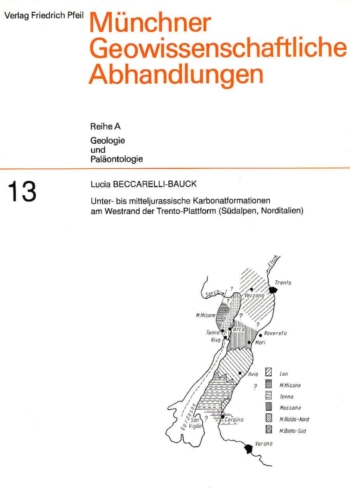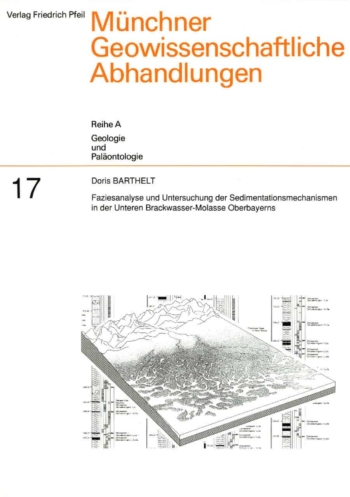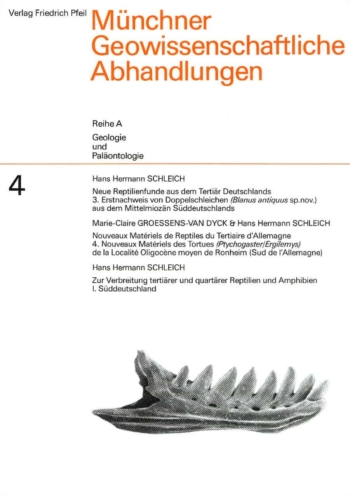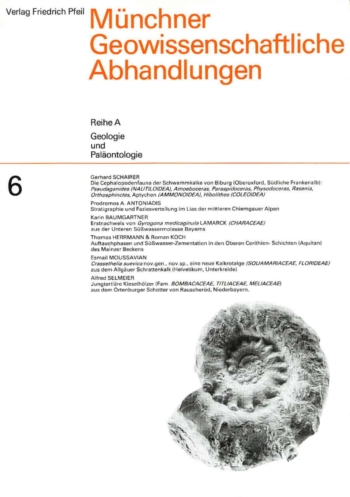Foreword V
Acknowledgements VII
Institutional Abbreviations IX
Abbreviations used in Figures XI
Historical Overview 1
Osteology and Phylogeny 2
Dating the Fossils 4
Systematic Section 7
Order Gymnophiona MÜLLER 1831 7
Family Caeciliidae GRAY 1825 7
Apodops ESTES and WAKE 1972 7
Order Caudata OPPEL 1811 8
The Suborders of the Caudata 9
Suborder Karauroidea nov. 10
Family Karauridae IVACHNENKO 1978 10
Karaurus IVACHNENKO 1978 10
Suborder Cryptobranchoidea DUNN 1922 13
Family Cryptobranchidae COPE 1889 13
Cryptobranchus LEUCKART 1821 13
Andrias TSCHUDI 1837 14
Family Hynobiidae COPE 1859 17
Suborder Prosirenoidea nov. 18
Family Prosirenidae ESTES 1969c 18
Prosiren GOIN and AUFFENBERG 1958 18
Ailbanerpeton ESTES and HOFFSTETTER 1976 20
Ramonellus NEVO and ESTES 1969 25
Suborder Proteoidea (NOBLE 1931) emend. EDWARDS 1976 26
Family Proteidae HOGG 1838 26
Proteus LAURENTI 1768 26
Mioproteus ESTES and DAREVSKY 1978 27
Necturus RAFINESQUE 1818 27
Orthophyia MEYER 1845 29
Family Batrachosauroididae AUFFENBERG 1958 29
Batrachosauroides TAYLOR and HESSE 1943 30
Opisthotriton AUFFENBERG 1961 33
Palaeoproteus HERRE 1935a 36
Peratosauroides NAYLOR 1980 37
Prodesmodon ESTES 1964 39
Suborder Amphiumoidea COPE 1889 41
Family Amphiumidae GRAY 1825 41
Amphiuma GARDEN 1821 41
Proamphiuma ESTES 1969b 43
Suborder Ambystomatoidea NOBLE 1931 45
Family Dicamptodontidae (TIHEN 1958) emend. EDWARDS 1976 45
Subfamily Dicamptodontinae TIHEN 1958 45
Dicamptodon STRAUCH 1870 45
Ambystomichnus PEABODY 1954 46
Bargmannia HERRE 1955 46
Chrysotriton n.gen. 46
Geyeriella HERRE 1950a 48
Wolterstorffiella HERRE 1950a 48
Subfamily Rhyacotritoninae TIHEN 1958 49
Family Scapherpetontidae AUFFENBERG and GOIN 1959 49
Scapherpeton COPE 1877b 50
Lisserpeton ESTES 1965a 51
Piceoerpeton MESZOELY 1967 52
Family Ambystomatidae HALLOWELL 1856 54
Ambystoma TSCHUDI 1838 54
Amphitriton ROGERS 1976 58
Suborder Plethodontoidea SMITH and TAYLOR 1948 59
Family Plethodontidae GRAY 1850 59
Subfamily Desmognathinae COPE 1859 60
Desmognathus BAIRD 1850 60
Subfamily Plethodontinae GRAY 1850 60
Plethodon TSCHUDI 1838 60
Aneides BAIRD 1849 61
Batrachoseps BONAPARTE 1839 61
Gyrinophilus COPE 1869 62
Pseudotriton TSCHUDI 1838 62
Suborder Salamandroidea NOBLE 1931 63
Family Salamandridae GRAY 1825 63
"Group I" genera 64
Chioglossa BOCAGE 1864 64
Megalotriton ZITTEL 1890 64
Mertensiella WOLTERSTORFF 1925 65
Salamandra LAURENTI 1768 66
Salamandrina FITZINGER 1826 70
"Group II" genera 71
Brachycornius MEYER 1860 71
Chelotriton POMEL 1853 72
Palaeopleurodeles HERRE 1941 77
Pleurodeles MICHAHELLES 1830 78
Tylototriton ANDERSON 1871 78
"Group III" genera 80
Archaeotriton MEYER 1860 80
Euproctus GENE 1838 81
Koalliella HERRE 1950a 81
Notophthalmus RAFINESQUE 1820 82
Oligosemia NAVÁS 1922 84
Procynops YOUNG 1965 84
Taricha GRAY 1850 85
Triturus RAFINESQUE 1815 87
Family Sirenidae GRAY 1825 90
Siren LINNAEUS 1766 91
Habrosaurus GILMORE 1928 94
Pseudobranchus GRAY 1825 95
Caudata Incertae Sedis 96
Comonecturoides HECHT and ESTES 1960 96
Hylaeobatrachus DOLLO 1884 96
Undetermined Caudata 97
Taxa Removed From The Caudata And Gymnophiona 97
Amphiuma norica BRUNNER 1956 97
Boomgardia salamandriformis VON HUENE 1947 98
"Epipolysemia" rusconi (COSTA 1851) 98
"Ichthyophis" muelleri BRUNNER 1954 98
Permotriturus TATARINOV 1968 98
Praesalamandra BRUNNER 1957 98
"Salamandra" perversa BRUNNER 1957 98
Prohypogeophis tunariense MARCUS 1945 98
Triassurus IVACHNENKO 1978 98
Vaughniella urodeloides KUHN 1964 99
Family, generic and specific synonyms 100
Geological and geographical distribution 101
Literature Cited 107
Index generum 114
HPH 2 • Gymnophiona, Caudata
1981. [Englisch] – XV, 115 Seiten, 31 Abbildungen.
25,5 x 20,5 cm, Paperback.
Reihe: Handbook of Paleoherpetology
60,00 €
zzgl. Versandkosten / Versandkostenfrei in D
Nicht vorrätig
A number of summaries or lists of fossil finds of salamanders have been made (e.g. KUHN 1938, 1962; ESTES 1965b, 1970; BRAME 1958, 1967; TIHEN 1968, CARROLL 1977, CARROLL and WINER 1977), but no comprehensive discussion of the fossil record of the group as a whole has been available. This is the result of several factors. The group is a small one and the delicacy of salamander skeletons has made them infrequently recovered as fossils. The relative simplicity and high variability that characterizes the salamander skeleton makes the search for discriminating character states a frustrating one. Interpretation of the remains has thus been difficult. Controversy has often arisen owing to the extensive paedomorphy that has operated in salamander evolution and the consequent difficulty of determining character state polarity or defining taxa and trends.
Most salamander fossils are of Cenozoic age; few Mesozoic finds are known, and those almost entirely from the Upper Cretaceous. Almost half of the fifty-six genera recognized here as fossils are referable to Holocene genera. Of the thirteen recognized families only four are extinct, and representatives of all living families except Hynobiidae have been described.
While the salamander fossil record is not extensive, it is probably a reasonable indication of past diversity in the sense that only the Hynobiidae remain unrepresented as fossils. The strongly endemic nature of the Holocene salamanders suggests that the relatively poor record of fossil salamanders in eastern Asia is responsible for the lack of hynobiids in the record. Salamanders appear also to have been restricted for a great part of their history to the northern continents, as indicated both by their present distribution and their fossil record.
Classification of salamanders into families has been relatively stable; few workers have disagreed with the boundaries established long ago and for the most part continued today. Controversy has arisen, however, in grouping of these families into suborders or superfamilies. NOBLE (1931) developed an arrangement that has been widely followed. WAKE (1966) and REGAI (1966) made some rearrangements but did not differ substantially from NOBLE. EDWARDS (1976) has reanalyzed older data and included new material on the pattern of spinal nerve exit from vertebrae. This arrangement is the most comprehensive yet published and although not computer-generated, was constructed according to cladistic methodology. NAYLOR (1978c) offered a conventional phylogenetic classification utilizing available data as well as adding his own studies on the vertebral column and trunk musculature. PRESCH (ms) is working presently on a cladistic phylogeny that will include all available data. All of these recent classifications agree with older ones (e. g. NOBLE 1931) in placing cryptobranchoids as primitive, salamandrids and plethodontids as highly derived. These classifications differ as to placement of the highly paedomorphic families Sirenidae, Proteidae and Amphiumidae, once again showing how the paedomorphic trends in many salamander groups have confused the evaluation of relationships. The extinct families pose still another problem since they cannot be sampled for important data on biochemistry, courtship, karyology, and other data based on soft structures; they must therefore be placed in any phylogenetic scheme on the more subjective aspects of general similarity and the few osteological features known for them.
Salamanders, as the most primitive living amphibians, have offered few clues to the ancestry of the group. Controversy has been as common in interpretation of salamander origins as it has in interpretation of taxa. The factors identified above that have caused difficulty in interpreting fossil salamanders have resulted in several elaborate attempts to delineate salamander ancestry – attempts that have been largely unsuccessful. One area of controversy has been whether living amphibians form a monophyletic group Lissamphibia (e. g. PARSONS and WILLIAMS 1963; BOLT 1977) or whether they have been derived from unrelated groups of Paleozoic amphibians (e.g. WAKE 1970; CARROLL and HOLMES 1980). Another area of controversy involves identification of the particular group of Paleozoic amphibians from which salamanders are derived. Some workers have favored the labyrinthodonts, specifically the dissorophoids (e. g. ESTES 1965b; BOLT 1977); others have sought urodele origins in the lepospondyls, in particular the microsaurs (e.g. CARROLL and CURRIE 1975). The enormous morphological and chronological gap that separates salamanders and Paleozoic forms makes it difficult to choose from these alternatives. The latest Paleozoic types of amphibians are Triassic; the earliest authenticated salamanders are Upper Jurassic. While the best known Upper Jurassic form (Karaurus) superficially resembles the labyrinthodonts owing to its extensive skull casque of sculptured dermal bone, it has a highly derived palate and is otherwise not like Paleozoic forms.
Other workers, particularly JARVIK (e.g. 1980), have hypothesized an origin of salamanders within the lobe-finned fishes, and separate from that of other amphibians. JURGENS (1971) has provided the most recent evidence negating this view.
These classifications and problems associated with the origins of salamanders will be discussed in more detail in the text of this volume. This brief discussion, however, indicates that we are still far from a coherent picture – much less a consensus – of salamander interrelationships. Moreover, while progress is being made, the great gaps in the fossil record have not yet permitted us to evaluate the position of salamanders vis-à-vis other amphibians in any satisfactory way.
Sie müssen angemeldet sein, um eine Rezension veröffentlichen zu können.
„*“ zeigt erforderliche Felder an
Ähnliche Produkte
-

Unter- bis mitteljurassische Karbonatformationen am Westrand der Trento-Plattform (Südalpen, Norditalien)
30,00 €zzgl. Versandkosten / Versandkostenfrei in D
-

Die Stinkkalke der produktiven Cyrenenschichten Süddeutschlands zwischen Lech und Inn (Egerian)
30,00 €zzgl. Versandkosten / Versandkostenfrei in D
Wir sind gerne für Sie da
Verlag Dr. Friedrich Pfeil
Wolfratshauser Str. 27
81379 Munich – Germany
Tel.: +49 89 55 28 6000
Fax: +49 89 55 28 6004
E-Mail: info@pfeil-verlag.de




Rezensionen
Es gibt noch keine Rezensionen.